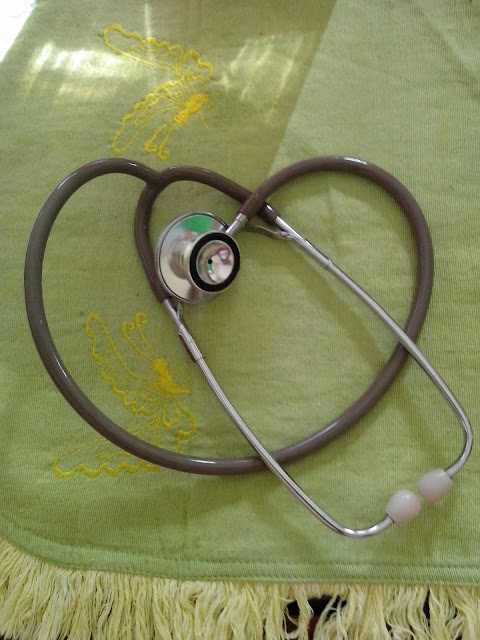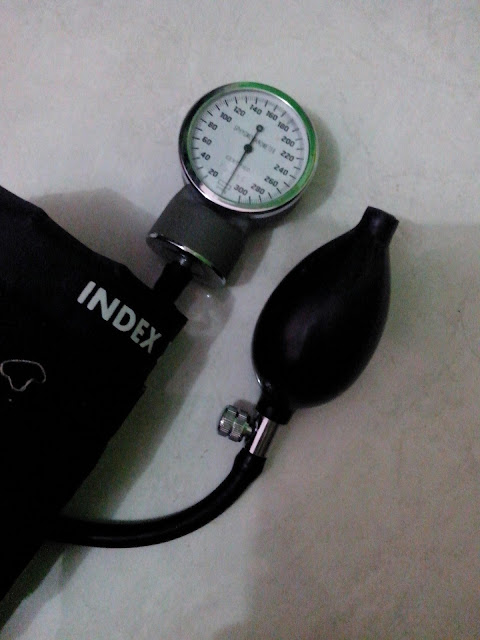A stethoscope is a medical device for listening to sounds inside the body. The initial stethoscope was invented in the early 19th century by French physician Ren� Laennec, but was actually trying to achieve a rather different end: doctor-patient distance....
Sunday, September 7, 2014
Maternal and Neonatal Care
Because of its profound emotional implications for mother and
child, maternal-neonatal care requires expertise that goes beyond clinical
skills. Such care must combine clinical competence, sensitivity, and good
judgment. It must consider the patient's sexuality and self-image and recognize
changing social attitudes and values—especially those concerning conventional
and alternative methods of conception and childbirth.
More than 4 million infants are born in the United States each
year. Many are born with considerably less medical intervention than was
customary in previous decades, and many were conceived with considerably more
intervention. As a result, nurses today must be prepared to implement or assist
with a wide range of procedures.
If you're working with a pregnant patient, you'll need to use your
teaching skills. For instance, you may be called on to organize and direct
natural childbirth classes or to teach the mother-to-be how to breathe and
control pain during childbirth. You may teach fathers and other support persons
to participate in childbirth by providing comfort and direction.
You may also be asked to give information about childbirth options.
Although most births still occur in a hospital, many parents inquire about
delivery in a birth center. Usually located on the maternity unit of a hospital
or sponsored by a childbirth association, a birth center combines the advantages
of a homelike setting with the emergency medical and nursing interventions
available in a hospital. Today's nurse may staff or direct the birth
center.
Historically, the midwife has been a fixture in remote or poor
communities. Today's professional nurse-midwife, however, brings advanced
technical skills and certification to diverse communities—urban center to
country town alike. She may work in collaboration with—or be supervised by—a
physician or a group. In some areas, she may even practice independently. In
fact, several states permit insurers to make direct payment to the nurse-midwife
for her services.
Accompanying the changes in maternity care are changes in neonatal
care—thanks to advanced knowledge and techniques for improving fetal
monitoring and promoting neonatal survival. New clinical evaluation methods,
combined with new electronic and biochemical monitoring techniques, allow
improved neonatal care. To make use of these advances, you must be familiar with
neonatal physiology, procedures, and equipment.
Thursday, August 21, 2014
HOW AGE AFFECTS DRUG ACTION
As the body ages, body structures and systems change, affecting how
the body responds to medications. Some common changes that significantly affect
medication administration follow.
Body composition
As a person grows older, his total body mass and lean body mass
tend to decrease while body fat tends to increase. These factors affect the
relationship between a drug's concentration and solubility in the
body.
Digestive system
Decreases in gastric acid secretion and GI motility lead to the
body's decreased ability to absorb many drugs well. This can cause problems with
certain drugs—for example, digoxin, whose narrow therapeutic range is tied
closely to absorption.
Hepatic system
Advancing age reduces blood supply, and certain liver enzymes
become less active. As a result, the liver loses some of its ability to
metabolize drugs. With reduced liver function comes more intense drug effects as
higher levels of a drug remain in circulation. This increases the incidence of
drug toxicity.
Renal system
Kidney function diminishes with age. This alone may impair drug
elimination by 50% or more. In many cases, decreased kidney function leads to
increased blood levels of certain drugs.
Boosting therapeutic compliance : Drug Therapy for Geriatric Care
-
To circumvent noncompliance caused by visual impairment, provide dosage instructions in large print if necessary.
-
To alter eating habits that lead to noncompliance, emphasize which drugs the patient must take with food and which he must take on an empty stomach. Explain that taking some drugs on an empty stomach may cause nausea, whereas taking some drugs on a full stomach may interfere with absorption. Also find out whether the patient eats regularly or skips meals. If he skips meals, he may be skipping doses too. As needed, help him coordinate his drug administration schedule with his eating habits.
-
To correct problems related to drug form and administration, help the patient find easier ways to take medicine. For example, if he can't swallow pills or capsules, switch to a liquid or powdered form of the drug if possible. Suggest that he slide the tablet down with soft food such as applesauce. Keep in mind which tablets you can crush and which you can't. For example, enteric-coated tablets, timed-release capsules, and sublingual and buccal tablets shouldn't be crushed. Doing so may affect absorption and effectiveness. Some crushed drugs may taste bitter and may stain or irritate oral mucosa.
-
If mobility or transportation deters compliance, help the patient locate a pharmacy that refills and delivers prescriptions. If appropriate, consider using a mail-order pharmacy.
-
If forgetfulness interferes with compliance, devise a system for helping the patient remember to take his drugs properly. Suggest that the patient or a family member purchase or make a scheduling aid, such as a calendar, checklist, alarm wristwatch, or compartmented drug container.
-
Some patients may try to save money by not having prescriptions filled or refilled or by taking fewer doses than ordered to make the drug last longer. If financial considerations are preventing your patient's compliance, help him explore new ways of managing. Suggest that he use less-expensive generic equivalents of name-brand drugs whenever possible. Also, explore ways that family members can help, or refer the patient to the social services department and appropriate community agencies. Many states have programs to help low-income elderly patients buy needed medications.
Monday, August 18, 2014
Preventing Reactions That Impede Compliance
-
Discuss the patient's drug therapy with him. As he receives drugs, name them, explain their intended effect, and describe possible adverse reactions to watch for and report.
-
Tell the patient that you'll ask questions to help identify (or reduce the risk of) harmful food or drug interactions (such as those caused by alcohol and caffeine) that may interfere with compliance.
-
Ask the patient about all drugs—prescription, nonprescription, and herbal remedies—he's currently taking and those he has taken in the past. If possible, ask to see samples. Have him name each drug and tell you why, when, and how often he takes it. Remember, the patient may have drugs prescribed by more than one physician. Ask whether he's taking any drugs originally prescribed for another person (a common occurrence).
-
If your facility has a specially designed computer program, use it to help prevent possible drug interactions. Enter all the data you've collected on drug dosage, frequency, and administration route into a master file of drugs commonly used by elderly patients, such as anticoagulants (warfarin), benzodiazepines (diazepam), beta-adrenergic blockers (propranolol), calcium channel blockers (verapamil), digitalis glycosides (digoxin), and diuretics (furosemide). From this information the computer compiles a list of the patient's drugs, possible adverse reactions, potential interactions, and suggested interventions. Then review the findings with the patient. If he knows what to expect, he'll be more likely to comply with treatment. (If you don't have access to such technology, you can compile a similar list using a reputable drug reference.)
-
Alternatively, encourage the patient to purchase drugs from only one pharmacy, preferably one that maintains a drug profile for each customer. Advise him to consult the pharmacist, who can anticipate drug interactions before they occur.
-
Inform the patient about specific food-drug interactions. Based on the information in your drug history, provide a list of food items to avoid.
Geriatric Care : Assessing Compliance Ability
-
Review the patient's complaint, and obtain a comprehensive health and drug history.
-
Keeping in mind that discharge planning begins at admission, evaluate the patient's physical ability to take drugs. Can he read drug labels and directions? Does he identify drugs by sight or by touch? Can he open drug bottles easily?If he's disabled by Parkinson's disease or arthritis, for example, or if he lacks manual dexterity for any reason, advise him to ask his pharmacist for snap or screw caps (rather than childproof closures) for his drug containers.
-
Evaluate the patient's cognitive skills. Can he remember to take prescribed drugs on time and regularly? Can he remember where he stored his drugs? If not, refer him to appropriate community resources for supervision.
-
Assess the patient's lifestyle. Does he live with family or friends? If so, include them in your patient-teaching sessions if possible. Does he live alone or with a debilitated spouse? If so, he'll need continuing support from a visiting nurse or other caregiver.
-
Keep in mind that inadequate supervision may result in drug misuse. Make appropriate referrals and contact appropriate social agencies to ensure compliance and safety and to provide financial assistance if necessary.
-
Assess the patient's beliefs about drug use. For example, the patient may believe that chronic use of medication is a sign of illness or weakness and therefore may take his medications erratically.
Sunday, August 17, 2014
Drug Therapy for Elderly Patients
Four out of five people over age 65 have one or more chronic
disorders. This helps explain why elderly people consume more medications than
any other age-group. Although elderly adults represent only 12% of the
population, they take 30% to 40% of the prescription drugs dispensed. That's
about 400 million prescriptions per year, or twice the number of prescriptions
filled for people under age 65.
Drug therapy for elderly patients presents a special set of
problems rooted in age-related changes. Physiologically, aging alters body
composition and triggers changes in the digestive system, liver, and kidneys. These changes
affect drug metabolism, absorption, distribution, and excretion and,
consequently, may lead to the need for altered drug dosages and administration
techniques. They also potentiate adverse reactions to drugs and may interfere
with therapeutic compliance.
Even when an elderly patient receives the optimum drug dosage, he's
still at risk for an adverse drug reaction. Ongoing physiologic changes, poor
compliance with the drug regimen, and greater drug consumption contribute to
elderly patients experiencing twice as many adverse reactions as younger
patients. In fact, about 40% of the people who experience adverse drug reactions
are over age 60.
Many older patients who experience signs and symptoms of adverse
drug reactions (such as confusion, weakness, and lethargy) blame them on the
disease rather than on the drugs they're taking. If the adverse reaction is
unidentified or misidentified, the patient will probably continue taking the
drug. To compound the problem, if the patient has multiple physical dysfunctions
or adverse drug reactions or both, he may consult several physicians or
specialists who—unknown to one another—may prescribe more drugs. If the
patient's drug history remains uninvestigated and the patient takes additional
nonprescription drugs to relieve common complaints (such as indigestion,
dizziness, and constipation), he may innocently fall into a pattern of
inappropriate and excessive drug use. Known as polypharmacy, this pattern imperils the patient's safety and
the drug regimen's effectiveness.
Although many drugs can cause adverse reactions, most serious
reactions in elderly patients result from relatively few drugs—namely
diuretics, antihypertensives, digitalis glycosides, corticosteroids, sleeping
aids, and nonprescription drugs.
Finally, the elderly patient may have difficulty complying with his
drug regimen because of hearing and vision deficits, forgetfulness, the need for
multiple drug therapy, poor understanding of dosage and directions, and various
socioeconomic factors (such as poverty and social isolation). Ensuring
successful compliance with drug therapy requires involving family members, the
pharmacist, and other caregivers in supervision and teaching tailored to the
patient's needs.
Equipment
Patient's medication record • appropriate drugs • written
dosage instructions • optional: compliance aids (pill containers, calendar or
other large-print teaching aids, premeasured injections).
Implementation
Noncompliance in elderly patients is so prevalent that it's no
wonder that most nurses rank handling it as a top priority when planning nursing
care. Follow these procedures to assess the patient's ability
or motivation to follow a drug regimen.
Assessing compliance ability
Preventing reactions that impede compliance
Boosting therapeutic compliance
Special considerations
-
Advise the patient to contact you or his physician before taking any nonprescription medications to avoid adverse drug interactions. If necessary, regularly monitor serum levels of such drugs as digoxin and potassium to avoid toxicity.
-
When the physician advises discontinuing a drug, instruct the patient to discard it—in the toilet if possible. This prevents others from using the drug and ensures that the patient won't continue taking it by mistake.
-
To avoid improper storage and possible drug deterioration, advise the patient to keep all prescribed drugs in their original containers. Tell him to keep in mind that some drugs deteriorate when exposed to light and that others decompose if they come in contact with other drugs, for example, in a pillbox. Before the patient stores drugs together, advise him to consult his pharmacist or physician.
-
Suggest that the patient store his medications in an area that's well-lighted (but protected from direct sunlight), not too warm or humid (not the bathroom medicine cabinet), and some distance from his bedside (not on a bedside table). If he keeps drugs at his bedside, he could accidentally overdose by taking them before he's fully awake and alert.
-
Instruct patients to notify health care professionals of the medications they're taking when planning diagnostic testing, procedures, surgery or epidural injections because some medications (such as diabetic agents and anticoagulants) must be discontinued before the event to avoid adverse effects.
Home care
If the patient is discharged from the facility with a new drug
regimen, schedule him for follow-up care by a visiting nurse to assess his ability to follow the regimen and to monitor his
response to therapy.
Documentation
Document all assessment findings and laboratory test results in the
patient's chart. Record all instructions and teaching materials given to the
patient, family members, or other caregivers. Keep a record of all drugs,
dosages, and adverse reactions and interventions. Describe the patient's
understanding of his drug regimen. Note all health and social service agency
referrals.
Friday, July 18, 2014
Achieving Healthy Mother, Baby, and Family Unit
Posted by
Channel Maymoon
Labels:
Lipincot,
Maternal and Fetal Health,
Maternity,
nursing
at
7:24 PM
INTRODUCTION TO MATERNITY NURSING
Providing care to childbearing families is aimed at the ideal of
having every pregnancy result in a healthy mother, baby, and family unit. The
nurse today faces many evolving and challenging issues in achieving this goal.
Such advances as in vitro fertilization and embryo freezing have afforded people
opportunities once thought impossible. An increasing number of high-risk
pregnancies result from such factors as drug abuse, acquired immunodeficiency
syndrome, late or no prenatal care, teenage pregnancies, and pregnancies in
women older than age 35. Technologic advances in high-risk obstetric units,
fetal monitoring, sonography, and neonatal intensive care units are now
providing the means to improve maternal health and save fetuses and infants who
would not have survived years ago.
Today's childbearing families have many options. The planned birth
may take place in the traditional hospital setting, a birthing center, or at
home. The primary care provider may be a physician, a certified nurse-midwife,
or a lay midwife. Birth-related choices commonly include the use of labor,
delivery, and recovery rooms or labor, delivery, recovery, and postpartum rooms;
various birthing positions and analgesic methods; alternative pain-relief
strategies such as hydrotherapy; and the decision to allow children and others
to be present during labor and delivery. Regionalization of obstetric services
has provided childbearing families with access to the technologic advances and
skilled personnel capable of managing pregnancy or neonatal complications.
Economic changes in the health care climate have dramatically
affected the practice of nursing as cost-containment considerations have
shortened the hospital length of stay. Many hospitals have adopted a practice of
12- to 24-hour discharge after delivery coordinated with home health care
follow-up.
This combination of advancing technology, pregnancy risk factors,
and changing economics challenges the nurse to be a highly skilled clinician and
outstanding communicator.
TERMINOLOGY USED IN MATERNITY NURSING
-
Gestation—pregnancy or maternal condition of having a developing fetus in the body.
-
Embryo—human conceptus up to the 10th week of gestation (8th week postconception).
-
Fetus—human conceptus from 10th week of gestation (8th week postconception) until delivery.
-
Viability—capability of living, usually accepted as 24 weeks, although survival is rare.
-
Gravida (G)—woman who is or has been pregnant, regardless of pregnancy outcome.
-
Nulligravida—woman who is not now and never has been pregnant.
-
Primigravida—woman pregnant for the first time.
-
Multigravida—woman who has been pregnant more than once.
-
Para (P)—refers to past pregnancies that have reached viability.
-
Nullipara—woman who has never completed a pregnancy to the period of viability. The woman may or may not have experienced an abortion.
-
Primipara—woman who has completed one pregnancy to the period of viability regardless of the number of infants delivered and regardless of the infant being live or stillborn.
-
Multipara—woman who has completed two or more pregnancies to the stage of viability.
-
Living children—refers to the number of children a woman has delivered who are living.
A woman who is pregnant for the first time is a primigravida and is
described as Gravida 1 Para 0 (or G1P0). A woman who delivered one fetus carried to
the period of viability and who is pregnant again is described as Gravida 2,
Para 1. A woman with two pregnancies ending in abortions and no viable children
is Gravida 2, Para 0.
Wednesday, July 16, 2014
STRENGTHENING PELVIC FLOOR MUSCLES
Posted by
Channel Maymoon
Labels:
exercises,
Geriatric,
Geriatric Care,
incontinence management,
Urinary Incontinence
at
3:28 PM
Stress incontinence, the most common kind of urinary incontinence
in women, usually results from weakening of the urethral sphincter. In men, it
may sometimes occur after a radical prostatectomy.
You can help male and female patients prevent or minimize stress
incontinence by teaching pelvic floor (Kegel) exercises to strengthen the
pubococcygeal muscles. Here's how.
Learning Kegel exercises
First, explain how to locate the muscles of the pelvic floor.
Instruct the patient to tense the muscles around the anus, as if to retain
stools.
To identify this area initially, teach the patient to tighten the
muscles of the pelvic floor to stop the flow of urine while urinating and then
to release the muscles to restart the flow. Once learned, these exercises can be
done anywhere. Although Kegel exercises shouldn't be done while urinating, they
can be done at any other time.
Establishing a regimen
Explain to the patient that contraction and relaxation exercises
are essential to muscle retraining. Suggest that the patient start out by
contracting the pelvic floor muscles for 5 seconds, relax for 5 seconds, and
then repeat the procedure as often as needed.
Typically, the patient starts with 10 contractions in the morning
and 10 at night, gradually increasing the relaxation and contraction time.
Advise the patient not to use stomach, leg, or buttock muscles.
Also discourage leg crossing or breath holding during these
exercises.
Sunday, June 22, 2014
Selection of Phlebotomy Venipuncture Site
Antecubital vein location varies slightly from person to person; however, two basic vein distribution arrangements referred to as the “H-shaped” and the “M-shaped” patterns are seen most often. The “H-shaped” pattern is so named because the most prominent veins in this pattern- the cephalic, cephalic median, median basilic, and basilic veins- are distributed on the arm in a way that resembles a slanted H. The most prominent veins of the M pattern- the cephalic, median cephalic, median basilic, and basilic veins- resemble the shape of an M. The H-shaped pattern is seen in approximately 70% of the population.
Factors in Vein Selection: Select the vein carefully. The brachial artery and several major nerves pass through the antecubital area. Accidental artery puncture and nerve injury are risks of venipuncture. Prioritizing veins can minimize the potential for accidental arterial puncture and nerve involvement. Typically, a tourniquet is used to aid in the selection of a vein unless specific tests require that a tourniquet not be used. A tourniquet is not necessary if veins are large and easily palpated. However, if only the basilic vein is visible without a tourniquet, one must be applied so the availability of safer veins (e.g. median and/or cephalic) can be assessed. Palpation is usually performed using the index finger. The collector’s thumb should not be used to palpate because it has a pulse beat. In addition to locating veins, the palpation pressure helps to differentiate veins from arteries, which pulsate, are more elastic, and have a thick wall.
Accidental Arterial Puncture: If during the procedure accidental arterial puncture is suspected (e.g. rapidly forming hematoma, rapid filling tube, and bright red blood), discontinue the venipuncture immediately. Remove the needle and apply direct forceful pressure to the puncture site for a minimum of 5 minutes until active bleeding has ceased. The nursing staff and physician must be notified and the incident documented according to institutional policy.
Consult with supervisory personnel to determine the suitability of the suspected arterial specimen for testing. If the specimen is acceptable it must be annotated that the specimen was an arterial specimen. In some cases different normal reference intervals are assigned to arterial blood. This information must be conveyed to the caregiver through Meditech Specimen Collection comment and Test Result comments.
Nerve Injury: If the patient feels a shooting, electric-like pain, or tingling or numbness proximal or distal to the venipuncture site, terminate the venipuncture and remove the needle immediately. Repeat the venipuncture in another site with a new sterile needle if needed. Document the incident and direct the patient to medical evaluation if indicated.
Friday, June 20, 2014
Take a look at the build up to the game from the inside
More Info

Read More
| |||||||||||||||||||||||||||||||||||||||||||||||||||||||||||||||||||||||||||||||||||||||||||||||||||||||||||||||||||||||||||||||||||||||||||||||||||||||||||||||||||||||||||||||||||||||||||||||||||||||||||||||||||||||||||||||||||||||||||||
Subscribe to:
Comments (Atom)
Powered by Blogger.

















